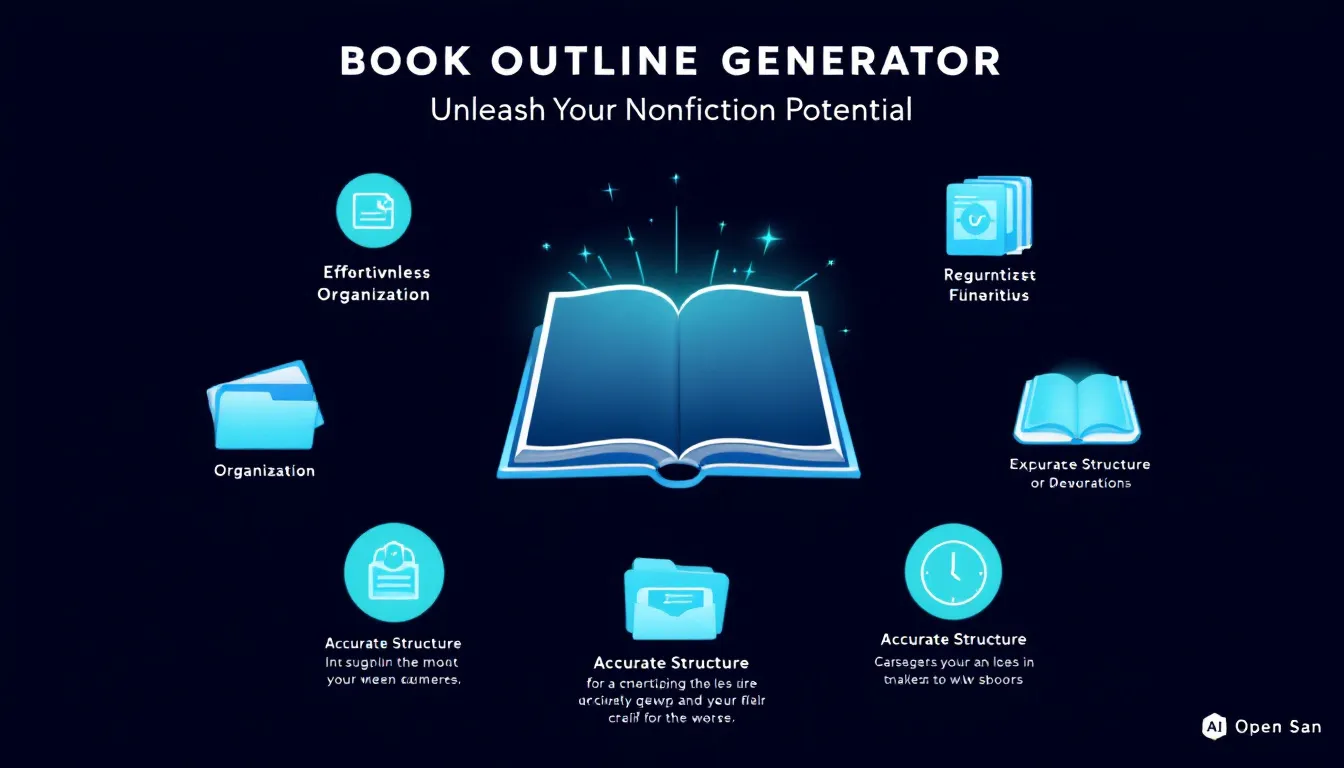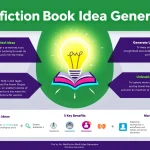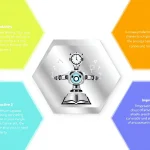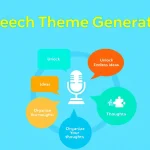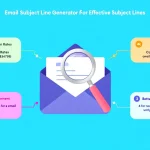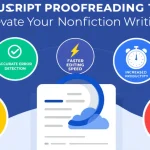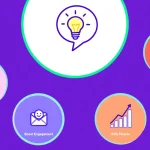Is this tool helpful?
How to Use the Book Outline Generator Effectively
The Book Outline Generator is a powerful tool designed to help aspiring nonfiction authors create a structured and comprehensive outline for their books. To use this tool effectively, follow these steps:
- Enter the main subject: In the first field, input the primary topic or theme of your nonfiction book. For example, you might enter “Artificial Intelligence” or “Sustainable Urban Development”.
- Provide the book title: In the second field, enter a catchy and informative title for your book. For instance, “The AI Revolution: Transforming Our World” or “Green Cities: Building a Sustainable Future”.
- Specify the target audience (optional): If you have a particular readership in mind, enter this information in the third field. For example, “Tech enthusiasts and business professionals” or “Urban planners and environmentally conscious citizens”.
- List key themes (optional): In the fourth field, outline the main ideas or concepts you want to explore in your book. For instance, for the AI book, you might enter “Machine learning, ethical considerations, AI in healthcare, future of work”. For the sustainable cities book, you could input “Green infrastructure, renewable energy, urban biodiversity, smart transportation systems”.
- Generate the outline: Click the “Generate Book Outline” button to create your customized book outline.
- Review and copy the results: Once generated, review the outline presented in the results section. You can then use the “Copy to Clipboard” button to easily transfer the outline to your preferred writing software.
By providing clear and specific information in each field, you’ll receive a more tailored and useful book outline to guide your writing process.
Unlocking Your Nonfiction Writing Potential: The Book Outline Generator
Writing a nonfiction book is a challenging yet rewarding endeavor that requires careful planning and organization. The Book Outline Generator is an innovative tool designed to streamline the outlining process, helping authors create a solid foundation for their work. This powerful resource combines the expertise of seasoned nonfiction writers with advanced AI technology to produce comprehensive, well-structured outlines tailored to your specific topic and title.
Whether you’re a first-time author or an experienced writer tackling a new subject, the Book Outline Generator offers invaluable assistance in crafting a compelling narrative structure. By providing a clear roadmap for your book, this tool enables you to focus on research and writing, confident in the knowledge that your content is organized effectively to engage and educate your target audience.
Key Features of the Book Outline Generator
- Customized outlines: Tailored to your specific topic, title, and target audience
- Comprehensive chapter structure: Well-organized chapters that contribute to the overall narrative
- Engaging introduction: Hooks to capture reader interest from the start
- Logical flow: Ensures a coherent progression of ideas throughout the book
- Thought-provoking conclusion: Ties together key insights and leaves a lasting impression
- Suggestions for supporting content: Ideas for case studies, examples, and research to bolster your arguments
Benefits of Using the Book Outline Generator
1. Time-saving Efficiency
One of the most significant advantages of using the Book Outline Generator is the tremendous time savings it offers. Creating a comprehensive outline for a nonfiction book can be a time-consuming process, often taking weeks or even months of brainstorming and planning. This tool condenses that process into mere minutes, allowing you to jumpstart your writing project with a solid foundation.
2. Structural Clarity
The Book Outline Generator provides a clear and logical structure for your nonfiction book. This structural clarity is crucial for maintaining reader engagement and ensuring that your ideas flow coherently from one chapter to the next. By offering a well-organized framework, the tool helps you avoid common pitfalls such as repetition, tangential content, or gaps in your argument.
3. Enhanced Focus
With a detailed outline at your fingertips, you can maintain better focus throughout the writing process. The generated outline serves as a roadmap, guiding you through each chapter and helping you stay on track with your main arguments and themes. This enhanced focus can lead to more efficient writing sessions and a more cohesive final product.
4. Flexibility and Customization
While the Book Outline Generator provides a comprehensive structure, it also offers the flexibility for customization. You can use the generated outline as a starting point and then adjust, expand, or refine it to better suit your specific vision for the book. This balance of structure and flexibility allows you to benefit from expert guidance while still maintaining your unique authorial voice.
5. Idea Generation
The tool not only organizes your existing ideas but also stimulates new ones. By suggesting potential chapters, subtopics, and areas for further exploration, the Book Outline Generator can inspire fresh perspectives and encourage you to delve deeper into your chosen subject matter. This feature is particularly valuable when you’re feeling stuck or unsure about how to expand on your initial concept.
6. Improved Content Quality
By providing a well-structured outline, this tool helps improve the overall quality of your book’s content. It ensures that you cover all essential aspects of your topic, maintain a balanced approach to different subtopics, and include necessary supporting elements such as case studies or research findings. This comprehensive approach results in a more thorough and authoritative nonfiction book.
7. Increased Confidence
For many authors, especially those new to nonfiction writing, the prospect of organizing an entire book can be daunting. The Book Outline Generator boosts your confidence by providing a professional-quality outline based on established nonfiction writing principles. This increased confidence can translate into more productive writing sessions and a greater likelihood of completing your book project.
Addressing User Needs and Solving Specific Problems
The Book Outline Generator is designed to address several common challenges faced by nonfiction authors:
1. Overcoming Writer’s Block
Many authors struggle with writer’s block, especially at the beginning of a project. By providing a detailed outline, this tool helps overcome that initial hurdle. For example, if you’re writing a book on personal finance titled “Financial Freedom: A Step-by-Step Guide to Wealth Building,” the generator might suggest chapters like:
- Understanding Your Current Financial Situation
- Setting SMART Financial Goals
- Budgeting Strategies for Success
- Mastering Debt Management
- Building and Diversifying Your Investment Portfolio
- Planning for Retirement: Start Early, Finish Rich
- Protecting Your Wealth: Insurance and Estate Planning
This structure immediately gives you a starting point, helping you overcome the intimidating blank page and begin writing with direction and purpose.
2. Ensuring Comprehensive Coverage
It’s easy to overlook important aspects of your topic when you’re deeply involved in the writing process. The Book Outline Generator helps ensure comprehensive coverage by suggesting a wide range of subtopics and angles to explore. For instance, if your book is about climate change, titled “Climate Crisis: Understanding and Combating Global Warming,” the tool might propose chapters that cover:
- The Science of Climate Change: Understanding the Basics
- Historical Perspective: How We Got Here
- Impacts on Ecosystems and Biodiversity
- Economic Consequences of Climate Change
- Social and Health Implications
- Technological Solutions: Renewable Energy and Beyond
- Policy Approaches: National and International Efforts
- Individual Action: What You Can Do to Make a Difference
This comprehensive approach ensures that you don’t overlook crucial aspects of your topic, resulting in a more thorough and authoritative book.
3. Maintaining Logical Flow
One of the biggest challenges in writing a nonfiction book is maintaining a logical flow of ideas throughout the work. The Book Outline Generator addresses this by creating a structure that builds upon itself, ensuring that each chapter flows naturally into the next. For example, in a book about entrepreneurship titled “From Idea to Empire: Building a Successful Startup,” the outline might progress as follows:
- Cultivating the Entrepreneurial Mindset
- Identifying and Validating Business Opportunities
- Crafting a Compelling Business Plan
- Securing Funding: Bootstrap, Angels, or Venture Capital?
- Building Your Dream Team
- Developing and Launching Your Minimum Viable Product
- Marketing Strategies for Startups
- Scaling Your Business: Managing Growth and Challenges
- Exit Strategies: IPOs, Acquisitions, and Beyond
This logical progression guides readers through the entrepreneurial journey, from initial concept to successful exit, ensuring a coherent and engaging narrative.
Practical Applications and Use Cases
The Book Outline Generator has numerous practical applications across various nonfiction genres and writing scenarios:
1. Academic Textbooks
Professors and researchers can use this tool to structure textbooks or academic publications. For instance, a professor writing a textbook on “Introduction to Psychology” could use the generator to create a comprehensive outline covering all major areas of the field, ensuring no crucial topics are omitted.
2. Self-Help and Personal Development Books
Authors in the self-help genre can benefit from the tool’s ability to create step-by-step outlines. A book on “Mastering Mindfulness: A 30-Day Journey to Inner Peace” could be structured with daily exercises, reflections, and progressive techniques, all neatly organized by the generator.
3. Business and Professional Guides
Entrepreneurs and industry experts writing books to share their knowledge can use the generator to create well-structured guides. A book on “Digital Marketing Mastery: Strategies for the Modern Business” could be outlined with chapters covering various digital marketing channels, analytics, and case studies.
4. Historical Narratives
Historians can use the tool to organize complex historical narratives. A book on “The Rise and Fall of Ancient Rome” could be structured chronologically, with the generator suggesting key events, figures, and societal changes to cover in each chapter.
5. Science Communication
Scientists and science communicators can use the generator to create outlines for books that explain complex scientific concepts to a general audience. A book titled “The Quantum World: Understanding the Building Blocks of Reality” could be structured to progressively introduce quantum concepts, their implications, and real-world applications.
Frequently Asked Questions
Q1: Can I use the Book Outline Generator for fiction writing?
A1: While the Book Outline Generator is primarily designed for nonfiction writing, creative writers may find it useful for structuring certain types of fiction, such as educational novels or books that incorporate factual information. However, for purely fictional works, you might want to explore tools specifically designed for fiction writing.
Q2: How detailed are the outlines generated by this tool?
A2: The outlines generated are comprehensive, typically including main chapters, subchapters, and suggestions for content to include. However, the level of detail can vary based on the information you provide. More specific inputs generally result in more detailed outlines.
Q3: Can I edit or customize the generated outline?
A3: Absolutely! The generated outline is a starting point. You’re encouraged to refine, expand, or modify the outline to better suit your specific vision for the book. The tool provides a solid foundation that you can build upon.
Q4: How long does it take to generate an outline?
A4: The Book Outline Generator typically produces results within a few minutes. However, the exact time may vary depending on the complexity of your topic and the current server load.
Q5: Do I need any special software to use the generated outline?
A5: No special software is required. The outline is generated in a simple text format that can be easily copied and pasted into any word processing software of your choice.
Q6: Can I use this tool for academic writing, such as theses or dissertations?
A6: While the Book Outline Generator is primarily designed for book-length nonfiction works, it can be adapted for academic writing. However, for highly specialized academic works, you may need to significantly customize the generated outline to meet specific academic requirements.
Q7: How often should I use the generator during my writing process?
A7: The generator is most useful at the beginning of your writing process to create an initial outline. However, you might find it helpful to revisit the tool if you decide to significantly change the direction or scope of your book during the writing process.
Q8: Can the Book Outline Generator help with book proposals?
A8: Yes! The detailed outline produced by the generator can be an excellent starting point for creating a book proposal. It provides a clear structure and overview of your book’s content, which is a crucial component of any book proposal.
By leveraging the power of the Book Outline Generator, you can streamline your nonfiction writing process, ensure comprehensive coverage of your chosen topic, and create a well-structured, engaging book that resonates with your target audience. Whether you’re a first-time author or an experienced writer, this tool can help you turn your ideas into a polished, professional outline, setting the stage for a successful writing journey.
Important Disclaimer
The calculations, results, and content provided by our tools are not guaranteed to be accurate, complete, or reliable. Users are responsible for verifying and interpreting the results. Our content and tools may contain errors, biases, or inconsistencies. We reserve the right to save inputs and outputs from our tools for the purposes of error debugging, bias identification, and performance improvement. External companies providing AI models used in our tools may also save and process data in accordance with their own policies. By using our tools, you consent to this data collection and processing. We reserve the right to limit the usage of our tools based on current usability factors. By using our tools, you acknowledge that you have read, understood, and agreed to this disclaimer. You accept the inherent risks and limitations associated with the use of our tools and services.
